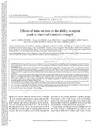Identificador persistente para citar o vincular este elemento:
https://accedacris.ulpgc.es/jspui/handle/10553/52537
| Campo DC | Valor | idioma |
|---|---|---|
| dc.contributor.author | García Manso, Juan Manuel | - |
| dc.contributor.author | Valverde, Teresa | - |
| dc.contributor.author | Arrones, Luis | - |
| dc.contributor.author | Navarro Valdivielso, Manuel E. | - |
| dc.contributor.author | Martin Dantas, Estelio H. | - |
| dc.contributor.author | Da Silva-Grigoletto, Marzo E. | - |
| dc.date.accessioned | 2018-11-29T11:11:09Z | - |
| dc.date.available | 2018-11-29T11:11:09Z | - |
| dc.date.issued | 2016 | - |
| dc.identifier.issn | 0022-4707 | - |
| dc.identifier.uri | https://accedacris.ulpgc.es/handle/10553/52537 | - |
| dc.description.abstract | BACKGROUND: The aim of this paper was to analyze how the rest between interval repetitions in intra-set training (at maximal isometric loads) could affect the ability to repeat maximal contractions in subjects with different levels of performance and different experience in strength development work. METHODS: Twenty subjects were divided randomly into two different groups depending on their sport characteristics: ten subjects were trained in strength development work (Group Strenght - 23.1±4.6 years; 172.0±5.3 cm; 79.9±12.1 kg; 2175.6±490.8 N; 46.9±4.9 mL/kg.min), and ten subjects were trained in endurance work (Group Endurance-21.3±4.5 years; 172.4±4.1 cm; 60.0±4.6 kg; 815.5±206.5 N; 67.4±4.9 mL/kg.min). To assess the ability to repeat maximal efforts, 20 repetitions of 5 seconds were performed in a half-squat position, with 1 minute of rest between repetitions. RESULTS: For both groups, four different phases were observed in the Interval Maximal Force test during the 20-repetition assessment: potentiation, maintenance, moderate loss, and significant loss. For the GE, the loss in maximum strength capacity began in the fourth repetition (GS4th: 3.4%, ns, Effect Size: 0.09 vs. GE3th: 1.6%; ns; ES: 0.06) and reached a statistically significant value in the twelfth repetition (GS12th: 12.7%, P=0.03, ES: 0.35 vs. GE7th: 12.5%; P=0.01; ES: 0.49). The number of repetitions at which the strength began to decrease depended on the subject's sport characteristic and performance level. CONCLUSIONS: This study shows how an appropriate intra-set rest inclusion can significantly increase the work performed in every set without changing the muscle contraction characteristics, thus delaying muscle fatigue and maintaining the desired training objective. | - |
| dc.language | eng | - |
| dc.publisher | 0022-4707 | - |
| dc.relation.ispartof | Journal of Sports Medicine and Physical Fitness | - |
| dc.source | Journal of Sports Medicine and Physical Fitness [ISSN 0022-4707], v. 56 (3), p. 214-222 | - |
| dc.subject | 241106 Fisiología del ejercicio | - |
| dc.subject.other | Exercise | - |
| dc.subject.other | Muscle fatigue | - |
| dc.subject.other | Muscle strength | - |
| dc.title | Effects of intra-set rest on the ability to repeat work at maximal isometric strength | - |
| dc.type | info:eu-repo/semantics/article | - |
| dc.type | Article | - |
| dc.identifier.scopus | 84964902668 | - |
| dc.identifier.isi | 000375357200007 | - |
| dc.contributor.authorscopusid | 6508074186 | - |
| dc.contributor.authorscopusid | 55234775400 | - |
| dc.contributor.authorscopusid | 57189044847 | - |
| dc.contributor.authorscopusid | 54973688300 | - |
| dc.contributor.authorscopusid | 35728322800 | - |
| dc.contributor.authorscopusid | 23481201700 | - |
| dc.description.lastpage | 222 | - |
| dc.identifier.issue | 3 | - |
| dc.description.firstpage | 214 | - |
| dc.relation.volume | 56 | - |
| dc.investigacion | Ciencias de la Salud | - |
| dc.type2 | Artículo | - |
| dc.contributor.daisngid | 1345341 | - |
| dc.contributor.daisngid | 12957148 | - |
| dc.contributor.daisngid | 7387670 | - |
| dc.contributor.daisngid | 28907646 | - |
| dc.contributor.daisngid | 522079 | - |
| dc.contributor.daisngid | 1417974 | - |
| dc.contributor.wosstandard | WOS:Garcia-Manso, JM | - |
| dc.contributor.wosstandard | WOS:Valverde, T | - |
| dc.contributor.wosstandard | WOS:Arrones, L | - |
| dc.contributor.wosstandard | WOS:Navarro-Valdivielso, M | - |
| dc.contributor.wosstandard | WOS:Dantas, EHM | - |
| dc.contributor.wosstandard | WOS:Da Silva-Grigoletto, ME | - |
| dc.date.coverdate | Marzo 2016 | - |
| dc.identifier.ulpgc | Sí | - |
| dc.description.sjr | 0,49 | |
| dc.description.jcr | 1,215 | |
| dc.description.sjrq | Q2 | |
| dc.description.jcrq | Q3 | |
| dc.description.scie | SCIE | |
| item.grantfulltext | open | - |
| item.fulltext | Con texto completo | - |
| crisitem.author.dept | GIR Praxiología motriz, entrenamiento deportivo, didáctica de las actividades físicas y salud | - |
| crisitem.author.orcid | 0000-0002-4360-3384 | - |
| crisitem.author.parentorg | Departamento de Educación Física | - |
| crisitem.author.fullName | García Manso, Juan Manuel | - |
| crisitem.author.fullName | Navarro Valdivielso, Manuel Evaristo | - |
| Colección: | Artículos | |
Citas SCOPUSTM
4
actualizado el 08-jun-2025
Citas de WEB OF SCIENCETM
Citations
4
actualizado el 25-feb-2024
Visitas
229
actualizado el 22-sep-2024
Descargas
138
actualizado el 22-sep-2024
Google ScholarTM
Verifica
Comparte
Exporta metadatos
Los elementos en ULPGC accedaCRIS están protegidos por derechos de autor con todos los derechos reservados, a menos que se indique lo contrario.
